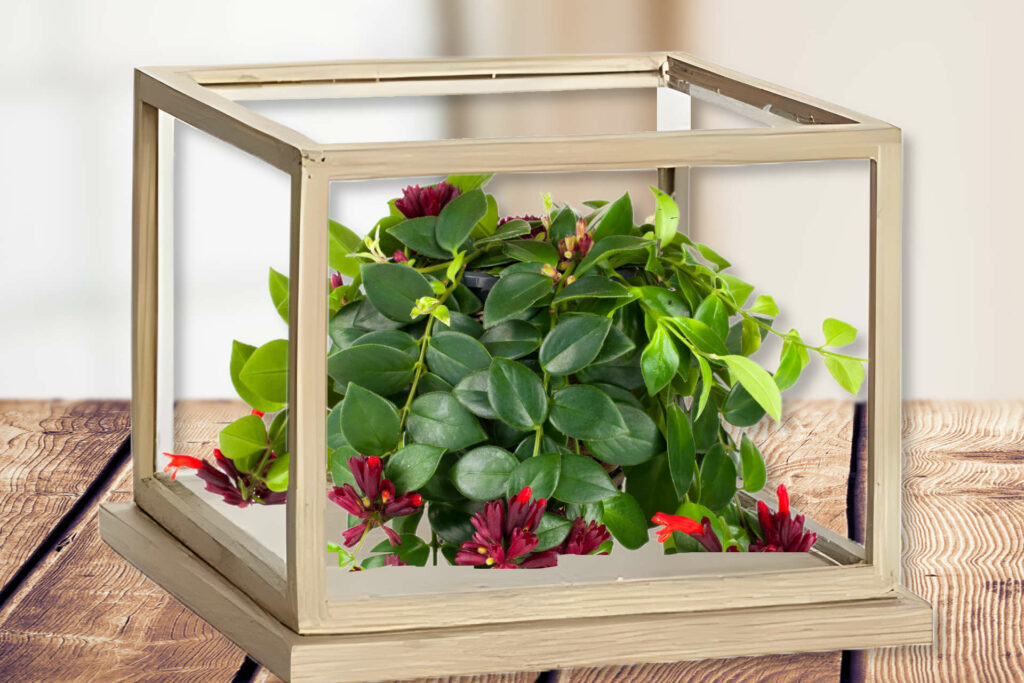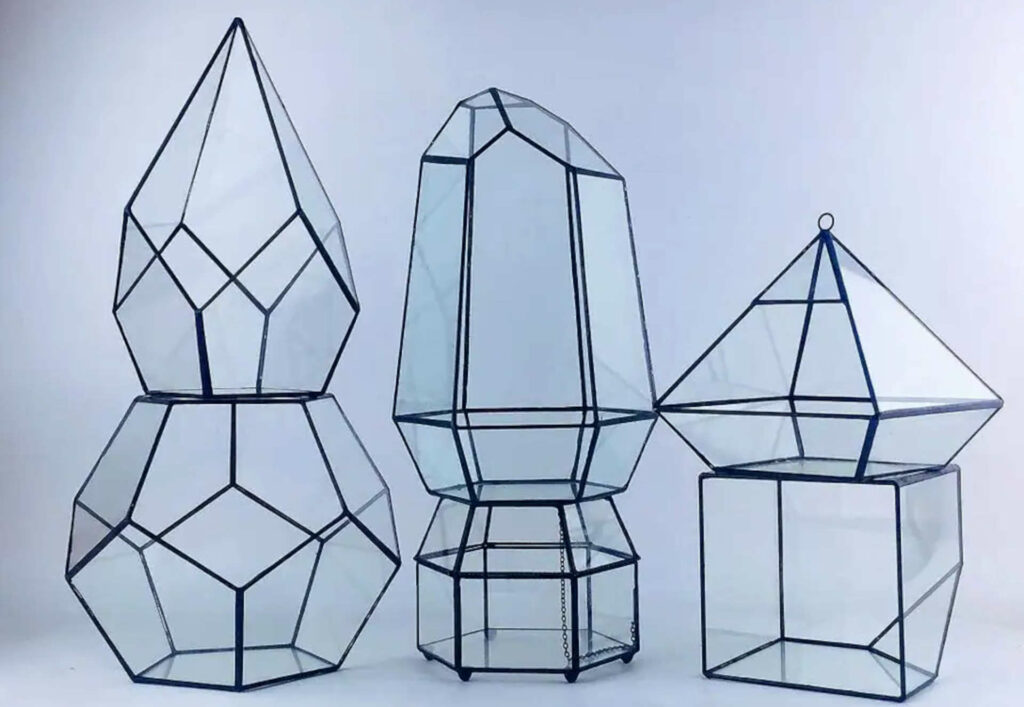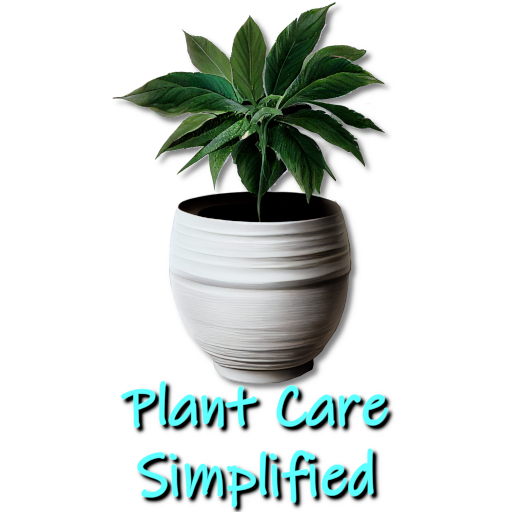Growing Lipstick Plants in Terrariums
Kim is passionate about helping people create beautiful, healthy indoor spaces that are filled with plants. Kim believes that plants make us happier, healthier human...
With their showy foliage and bright blooms, lipstick plants are excellent choices for terrarium growing. These epiphytic plants are native to tropical regions of South and Central America. In the wild, they grow on trees and rocks, absorbing moisture and nutrients from the air. This makes them ideal candidates for enclosed terrariums and vivariums where humidity is high.
Lipstick plants (Aeschynanthus) feature oval-shaped green leaves edged with a band of magenta or red and are great plants to grow in a terrarium. Their foliage takes on a bronze tint when exposed to bright light. Spikes of tiny tubular flowers in shades of red, orange, or yellow emerge at intervals. The blooms resemble little tubes of lipstick, giving the plant its common name. Together with an appropriately decorated terrarium or vivarium (totally enclosed unit), it can make the Lipstick plant an eye-catching feature of your home or office.
Why Choose a Terrarium? to Grow Lipstick Plants

Growing Lipstick Plants in terrariums offers a unique blend of aesthetic appeal and horticultural benefits. Terrariums provide a controlled environment that can be tailored to the specific needs of the Lipstick Plant, such as humidity and light. This makes it an ideal choice for both novice and experienced plant enthusiasts.
The main in benefits of growing lipstick plants in terrariums:
Easy Care
As tropical plants that thrive in humid conditions, lipstick plants are very low maintenance when grown in an enclosed terrarium. Their needs for water, humidity, light, and soil are easily met in this environment. Beginners often have great success with lipstick plants.
Add Color
With their colorful foliage and blooms, lipstick plants provide vivid visual interest to a terrarium's palette. They contrast nicely with green foliage plants and brighten shaded areas.
Unique Form and Texture
The oval leaves and cascading habit of lipstick plants add appealing form and texture impact. They make excellent focal point plants and contrast well with finer-leaved terrarium plants.
Air Purifying
Like many tropical plants, lipstick plants naturally filter toxins and purify the air. This makes them great additions to a closed terrarium environment.
When setting up a habitat for lipstick plants, there are a few key considerations to ensure their health and growth:
- Humidity - Maintain 60-80% relative humidity
- Light - Bright indirect or filtered light
- Soil - Well-draining tropical plant mix
- Watering - Avoid overwatering
With the right setup and care, these humidity-loving plants will thrive and add beautiful pops of color to a terrarium display. Their versatile nature makes them ideal candidates for beginner and advanced terrarium gardeners alike.
Selecting the Right Lipstick Plant Varieties
When choosing lipstick plant varieties for terrarium growing, there are a few popular options that tend to thrive in enclosed environments. However, part of the fun can be experimenting with more unusual selections as well.
Most Popular Varieties
These time-tested lipstick plant varieties are good bets for terrarium success:
- Aeschynanthus radicans - The most common lipstick plant has green and red variegated leaves. It cascades nicely and blooms in orange-red. A relatively compact variety.
- Aeschynanthus 'Thai Pink' - Features wider leaves with bright pink edges. Pink blooms give it a very tropical look. Larger and more vigorous than other varieties.
- Aeschynanthus 'Mona Lisa' - Has intriguing gray-green and burgundy foliage for subtle color. Pale yellow blooms. Compact habit but largish leaves.
The above types are all easy to find, straightforward to grow, and add plenty of visual pop. They are great starter plants for lipstick plant enthusiasts.
More Unusual Varieties
For terrarium gardeners seeking unique plants, consider these fun alternatives:
- Aeschynanthus 'Black Pagoda' - Striking black foliage with green undersides. Red flowers for contrast. The Black Pagoda can be difficult to find, but it makes a statement.
- Aeschynanthus 'Thai Orange' - Vibrant orange and purple leaves. Compact form. Blooms are also orange. Provides neon color impact.
While less common, these types of lipstick plants can give a terrarium exotic appeal. Do your research before purchasing to ensure they match your growing conditions and environment.
With so many varieties to consider, selecting the perfect lipstick plants is part of the fun of assembling a thriving terrarium. Their diversity allows for endless customization and display possibilities.
Providing the Ideal Growing Conditions
As tropical epiphytes, lipstick plants require specific conditions to thrive in an enclosed terrarium environment. With the lipstick plant terrarium setup, careful attention to humidity, light, soil, and watering will keep plants healthy and encourage lush growth and blooms.
Maintaining High Humidity
Humidity Levels
Lipstick Plants thrive in a humid environment, ideally with humidity levels ranging between 60-80%. Lower humidity levels can lead to dry leaves and reduced flowering, while excessively high humidity can encourage mold growth and root rot.
Humidity Control Devices
To maintain optimal humidity, consider using devices like hygrometers to monitor levels accurately. Small terrarium humidifiers can also be beneficial, especially in drier climates or during winter months. Alternatively, a pebble tray filled with water placed under the terrarium can help increase humidity naturally.
Troubleshooting Humidity Issues
If you notice signs of low humidity, such as brown leaf tips, consider misting the plant lightly with water. On the other hand, signs of excessive humidity may include mold growth or a musty smell, which would require improved ventilation.
- Use a glass enclosure with a solid top or access holes rather than large vented openings. This contains moisture better.
- Include a false bottom or drainage layer filled with pebbles, gravel, or LECA clay pebbles. This reservoir increases ambient humidity through evaporation.
- Mist plants daily using a spray bottle. Avoid wetting flowers to prevent rot.
- Place a shallow water dish inside the terrarium.
- Use a hygrometer to monitor humidity and make adjustments as needed.
Providing Bright Indirect Light
In their native habitat, lipstick plants grow under the shelter of jungle canopies in shaded, filtered light. Replicate these conditions indoors.
Artificial vs. Natural Light
Both types of light can be effective, but the key is to provide bright, indirect light for at least 6-8 hours a day. Direct sunlight can cause leaf burn, while insufficient light can lead to leggy growth and reduced flowering.
Light Placement and Adjustment
If using artificial lights, place them about 6-12 inches above the terrarium. The lights should be adjustable to mimic natural day-night cycles. If you're relying on natural light, rotate the terrarium occasionally to ensure even light distribution.
Light Spectrum
If using artificial lights, opt for full-spectrum LED lights, which closely mimic natural sunlight and are energy-efficient.
- East or west-facing windowsills are ideal spots. Avoid direct southern exposures.
- Sheer curtains can filter intense light. Move plants further away from light sources if leaves appear burned.
- Full-spectrum grow lights can substitute for natural lighting in darker rooms. Place 6-12 inches above plants.
- Aim for 12-14 hours of bright, indirect light per day.
Soil Mixture for Terrariums
Using the right potting medium with your Lipstick plant is essential. A porous potting medium provides the aeration a lipstick plant roots require.
Soil Mixture for Terrariums
Components
The ideal soil mixture for Lipstick Plants in terrariums consists of a balanced blend of organic matter, sand, and perlite. Generally, we have found a ratio of 2:1:1 of organic matter to sand to perlite provides excellent drainage while retaining essential nutrients.
pH Levels
Maintaining a neutral to slightly acidic pH level between 6.0 and 7.0 is crucial for optimal growth. As with all plants, we must emphasize the importance of regular pH testing.
- Use a peat-based tropical plant soil orchid mix, or create a custom blend.
- Incorporate perlite, orchid bark, moss, or coconut coir to improve drainage.
- Terracotta pots allow excess moisture to evaporate from their sides.
- Test pH regularly
Watering in a Terrarium
The key to watering Lipstick Plants in a terrarium is balance. The soil should be consistently damp but not waterlogged. Generally, watering once every 7-10 days is sufficient, but this can vary depending on the humidity and temperature.
Signs of Overwatering and Underwatering
Yellow leaves and a musty smell are common signs of overwatering. In contrast, dry, brittle leaves indicate underwatering. Adjust your watering schedule based on these symptoms.
Water Quality
Using distilled or rainwater is preferable as tap water can contain minerals that may affect the soil's pH level.
- Water when the top inch of soil feels dry. Take care not to overwater.
- Pour water slowly around the edges of pots to avoid wet foliage.
- Allow pots to drain fully after watering before returning to the terrarium.
- Yellow leaves indicate overwatering back off if the soil stays soggy.
With a well-sealed terrarium providing humidity, an ideal growing medium, proper lighting, and attentive watering habits, lipstick plants will thrive!
Terrarium Design and Planting

When designing a lipstick plant terrarium, considerations like size, materials, access, and arrangement are key for creating an attractive enclosed environment.
Terrarium Setups
Closed vs. Open Terrariums
Closed terrariums offer higher humidity levels, making them suitable for Lipstick Plants, which thrive in humid conditions. However, open terrariums allow for better air circulation, reducing the risk of diseases like root rot. The choice between the two depends on your specific care capacity.
Size and Dimensions
The Lipstick Plant is a moderate grower, and articles from experience, we would recommend a medium-sized terrarium, ideally between 12 to 18 inches in height and width.
Choosing an Appropriate Terrarium
- Opt for a 5-10 gallon glass tank or Wardian case for starter terrariums. Larger is better for air circulation.
- Ensure there is a way to access plants for care - front doors, removable lid, or side panel.
- Airtight, transparent materials help contain humidity while allowing light transmission.
- Terrariums with ventilation gaps lose more moisture but discourage fungal growth. Balance goals.
Arranging Plants and Hardscape
One of the advantages of growing lipstick plants in a terrarium is the ability to create an interesting and beautiful vista. You can surround the plant in imaginative ways, with hardscape elements, props, or interesting artifacts, making it the focal point.
- Use hardscape elements like rocks, driftwood, and moss to add visual interest.
- Choose a focal point plant like a blooming lipstick plant as a centerpiece.
- Arrange supporting plants with varying heights, textures, and colors around it.
- Lipstick plants can be tucked into wood crevices or trail down from suspended moss panels.
Propagation in Terrariums
Methods
Cuttings are the most straightforward method for propagating Lipstick Plants. Take a 4-6 inch cutting from a healthy stem, remove the lower leaves, and plant it directly into the terrarium soil.
Rooting Hormones
Although not mandatory, using a rooting hormone can speed up the rooting process. Apply a small amount to the cut end before planting.
Aftercare
Keep the soil consistently moist but not waterlogged during the initial weeks. Once the cutting has rooted, which usually takes 2-4 weeks, you can gradually reduce the watering frequency.
Signs of Successful Propagation
New leaf growth and a firmly anchored cutting are good indicators that the propagation has been successful.
- Carefully remove plants from nursery pots without damaging roots. Loosen tangled roots.
- Partially fill terrarium planters with porous soil mix. Top off after planting.
- Water thoroughly after planting and mist foliage. Acclimate plants gradually if coming from lower humidity.
- Monitor the first few weeks closely. Leaves may be yellow while plants adjust but should recover.
With thoughtful terrarium construction and planting, lipstick plants quickly adapt and begin growing happily in their new miniature ecosystem.
Ongoing Lipstick Plant Care
Lipstick plant care in terrariums is relatively easy compared to growing them as houseplants. However, some ongoing maintenance is required to keep plants healthy, encourage new growth, and promote flowering.
Maintaining Ideal Conditions
- Check soil moisture regularly and water when just starting to dry out. Feel the weight of the terrarium to gauge water needs.
- Monitor humidity levels. Mist or add water to the reservoir if the humidity drops below 60%.
- Watch for pests like aphids, mealybugs, and scale. Isolate and treat plants if infested.
- Ensure lighting is adequate as seasons change. Supplement natural light with grow bulbs as needed.
Troubleshooting Common Problems
- Yellow leaves - Usually a sign of overwatering. Allow soil to dry out more between waterings.
- Leaf edema - Blisters on leaves come from excess moisture. Improve air circulation and cut back on watering.
- Leggy growth - Not enough light causes lanky growth. Move the terrarium or add grow lights.
Pruning and Training Growth
- Prune leggy stems back to a leaf node to encourage bushier new growth.
- Gently tie or train trailing stems to supports. This keeps growth tidy and contained.
- Remove faded blooms to prolong flowering. Cut back flower spikes after bloom.
Encouraging Flowering
Lipstick plants are at their best in bloom,so taking measures to encourage your lipstick plant to bloom is important.
- Ensure plants get enough bright, indirect light to promote blooms.
- Use a balanced liquid fertilizer monthly during spring and summer.
- Keep the terrarium a bit drier during the winter rest period to stimulate flowers.
With attentive care and optimum conditions, lipstick plants will thrive for years in a well-maintained terrarium environment.
Final Thoughts: Enjoying Lipstick Plants in Terrariums
Growing lipstick plants in terrariums enclosed as vivarium plants allows both beginning and expert gardeners to cultivate these beautiful tropical epiphytes successfully. Their colorful foliage, trailing stems, and vivid blooms make them excellent terrarium specimens.
By replicating the warm, humid, indirect light conditions of their jungle habitat, lipstick plants will thrive and add a pop of color and texture. Varieties range from common to exotic, so there are endless options to suit your style.
With the right terrarium setup, soil mix, watering habits, and ongoing care, lipstick plants create a lush miniature ecosystem right in your home. Attentive maintenance keeps them healthy and encourages prolific flowers.
Lipstick plants are relatively trouble-free terrarium plants that provide lasting beauty and interest. Their cascading forms and colorful leaves complement other plants and bring a piece of the tropics indoors.
Whether starting out or looking to expand your planted terrarium collection, lipstick plants are sure to satisfy and delight. Their versatility, easy care requirements, and spectacular displays make them a top choice for successful terrarium gardening adventures.
Frequently Asked Questions
What size terrarium do I need?
For one or two small lipstick plants, a 5-gallon tank is sufficient. Larger varieties will need more space - aim for 10+ gallons. Make sure to allow for future plant growth too.
How often should I water the plants?
Check soil moisture weekly and water when the top inch becomes dry. Water less frequently in cooler months or in a very humid environment.
What's the best lipstick plant variety for beginners?**
Aeschynanthus radicans is the most common, adaptable, and easiest to find. It's a great starter variety to gain experience.
How much light do lipstick plants need?
Lipstick plants like bright, indirect light. An east or west window is often ideal. 12-14 hours daily is recommended. Supplement with grow lights if needed.
How do I increase humidity in a terrarium?
Use an enclosed tank, add a reservoir layer, mist often, include water features, and monitor humidity. The ideal range is 60-80%.
What's causing brown leaf tips on my plant?
This is usually a result of dry air. Boost humidity levels and cut back on watering slightly if soil is staying wet.
Why aren't my lipstick plants blooming?
Insufficient light is the most common cause. Increase light exposure to 12-14 hours daily. Fertilizing regularly can also encourage blooms.
Should I fertilize plants in a closed terrarium?
Use a weak liquid fertilizer monthly during spring and summer for optimum growth and flowering. Avoid over-fertilizing in a confined space.
Videos
Kim is passionate about helping people create beautiful, healthy indoor spaces that are filled with plants. Kim believes that plants make us happier, healthier human beings, and she loves sharing her knowledge with others so they can experience the joys of plant care for themselves. <a href="https://plantcaresimplified.com/kim-marson/">Read more</a>
More Posts